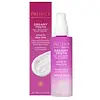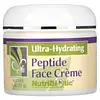What's inside
What's inside
 Key Ingredients
Key Ingredients

 Benefits
Benefits

 Concerns
Concerns

 Ingredients Side-by-side
Ingredients Side-by-side

Water
Skin ConditioningHelianthus Annuus Seed Oil
EmollientEthylhexylglyceryl Palmitate
EmulsifyingAcetyl Hexapeptide-8
HumectantGlyceryl Stearate
EmollientCetyl Alcohol
EmollientPalmitoyl Tripeptide-3
Butyrospermum Parkii Oil
EmollientVitis Vinifera Seed Oil
EmollientAloe Barbadensis Leaf Juice
Skin ConditioningLaminaria Hyperborea Extract
Skin ProtectingTocopheryl Acetate
AntioxidantMagnesium Ascorbyl Phosphate
AntioxidantPrunus Amygdalus Dulcis Oil
Skin ConditioningHyaluronic Acid
HumectantTheobroma Cacao Seed Butter
EmollientPanthenol
Skin ConditioningAllantoin
Skin ConditioningXanthan Gum
EmulsifyingAlgin
MaskingAvena Sativa Bran
AbrasiveCocos Nucifera Water
MaskingIris Pallida Leaf Cell Extract
AntioxidantRosa Damascena Leaf Cell Extract
Skin ProtectingCichorium Intybus Root Oligosaccharides
Skin ConditioningCaesalpinia Spinosa Gum
Skin ConditioningCucumis Sativus Fruit Extract
EmollientPhenoxyethanol
PreservativeEthylhexylglycerin
Skin ConditioningPelargonium Graveolens Oil
MaskingWater, Helianthus Annuus Seed Oil, Ethylhexylglyceryl Palmitate, Acetyl Hexapeptide-8, Glyceryl Stearate, Cetyl Alcohol, Palmitoyl Tripeptide-3, Butyrospermum Parkii Oil, Vitis Vinifera Seed Oil, Aloe Barbadensis Leaf Juice, Laminaria Hyperborea Extract, Tocopheryl Acetate, Magnesium Ascorbyl Phosphate, Prunus Amygdalus Dulcis Oil, Hyaluronic Acid, Theobroma Cacao Seed Butter, Panthenol, Allantoin, Xanthan Gum, Algin, Avena Sativa Bran, Cocos Nucifera Water, Iris Pallida Leaf Cell Extract, Rosa Damascena Leaf Cell Extract, Cichorium Intybus Root Oligosaccharides, Caesalpinia Spinosa Gum, Cucumis Sativus Fruit Extract, Phenoxyethanol, Ethylhexylglycerin, Pelargonium Graveolens Oil
Water
Skin ConditioningPalmitoyl Pentapeptide-4
Skin ConditioningAloe Barbadensis Leaf Juice
Skin ConditioningGlycerin
HumectantAcetyl Hexapeptide-8
HumectantHelianthus Annuus Seed Oil
EmollientGlyceryl Stearate
EmollientEthylhexyl Palmitate
EmollientMagnesium Ascorbyl Phosphate
AntioxidantPolysilicone-11
Aminobutyric Acid
Panax Ginseng Root Extract
EmollientPortulaca Oleracea Extract
Skin ConditioningCentella Asiatica Extract
CleansingCetearyl Alcohol
EmollientPhenoxyethanol
PreservativeDimethicone
EmollientParfum
MaskingPanthenol
Skin ConditioningCitrus Grandis Seed Extract
AstringentTocopheryl Acetate
AntioxidantTocopherol
AntioxidantLinum Usitatissimum Seed Oil
PerfumingBorago Officinalis Seed Oil
EmollientRosa Canina Seed Extract
EmollientCamellia Sinensis Leaf Extract
AntimicrobialPrunus Amygdalus Dulcis Oil
Skin ConditioningAllantoin
Skin ConditioningEthylhexylglycerin
Skin ConditioningOlea Europaea Fruit Oil
MaskingLecithin
EmollientRetinyl Palmitate
Skin ConditioningWater, Palmitoyl Pentapeptide-4, Aloe Barbadensis Leaf Juice, Glycerin, Acetyl Hexapeptide-8, Helianthus Annuus Seed Oil, Glyceryl Stearate, Ethylhexyl Palmitate, Magnesium Ascorbyl Phosphate, Polysilicone-11, Aminobutyric Acid, Panax Ginseng Root Extract, Portulaca Oleracea Extract, Centella Asiatica Extract, Cetearyl Alcohol, Phenoxyethanol, Dimethicone, Parfum, Panthenol, Citrus Grandis Seed Extract, Tocopheryl Acetate, Tocopherol, Linum Usitatissimum Seed Oil, Borago Officinalis Seed Oil, Rosa Canina Seed Extract, Camellia Sinensis Leaf Extract, Prunus Amygdalus Dulcis Oil, Allantoin, Ethylhexylglycerin, Olea Europaea Fruit Oil, Lecithin, Retinyl Palmitate
Ingredients Explained
These ingredients are found in both products.
Ingredients higher up in an ingredient list are typically present in a larger amount.
Acetyl Hexapeptide-8, commonly known as Argireline or Acetyl Hexapeptide-3, is a popular peptide in skincare. It’s often referred to as a “Botox-like” ingredient because it helps reduce muscle movement.
By relaxing these micro-movements, Argireline may help minimize the appearance of fine lines and wrinkles. That said, it’s not as powerful as Botox, and research on its long-term effectiveness is still limited.
Beyond smoothing, Argireline may also support collagen production. Collagen is the protein that helps keep your skin firm, bouncy, and well-hydrated by strengthening the skin barrier.
So while Argireline isn’t a miracle fix, it can be a helpful addition to a routine focused on both prevention and skin health.
Read more about other common types of peptides here:
Learn more about Acetyl Hexapeptide-8Allantoin is a soothing ingredient known for its protective and moisturizingg properties. Because of this, it is often added to products with strong active ingredients.
Studies show higher concentrations of this ingredient can promote wound healing.
Though it can be derived from the comfrey plant, allantoin is produced synthetically for cosmetic products to ensure purity.
Learn more about AllantoinAloe Barbadensis Leaf Juice comes from leaves of the aloe plant. Aloe Barbadensis Leaf Juice is best known for helping to soothe sunburns. It is also anti-inflammatory, moisturizing, antiseptic, and can help heal wounds.
Aloe is packed with good stuff including Vitamins A, C, and E. These vitamins are antioxidants, which help fight free-radicals and the damage they may cause. Free-radicals are molecules that may damage your skin cells, such as pollution.
Aloe Barbadensis Leaf Juice also contains sugars. These sugars come in the form of monosaccharides and polysaccharides, folic acid, and choline. These sugars are able to help bind moisture to skin.
It also contains minerals such as calcium, 12 anthraquinones, fatty acids, amino acids, and Vitamin B12.
Learn more about Aloe Barbadensis Leaf JuiceEthylhexylglycerin (we can't pronounce this either) is commonly used as a preservative and skin softener. It is derived from glyceryl.
You might see Ethylhexylglycerin often paired with other preservatives such as phenoxyethanol. Ethylhexylglycerin has been found to increase the effectiveness of these other preservatives.
Glyceryl Stearate is a mix of glycerin and stearic acid.
It is used to stabilize the mixing of water and oil ingredients. By preventing these ingredients from separating, it can help elongate shelf life. It can also help thicken the product's texture.
As an emollient, it helps soften skin and supports barrier-replenishing ingredients.
In cosmetics, Glyceryl Stearate is often made from vegetable oils or synthetically produced.
This ingredient may not be fungal-acne safe
Fun fact: The human body also creates Glyceryl Stearate naturally.
Learn more about Glyceryl StearateHelianthus Annuus Seed Oil is the oil derived from the seeds of a Sunflower. Sunflower seed oil is non-fragrant. It is an emollient, meaning it helps to soften the skin.
Sunflower seed oil contains many fatty acids. The fatty acids found in sunflower seeds include (from highest amount to least): linoleic acid, myristic acid, palmitic acid, stearic acid, arachidic acid, oleic acid, and linolenic acid.
These fatty acids help the skin create ceramides. Ceramides play a role in repairing the skin barrier.
Helianthus Annuus Seed Oil helps moisturize the skin. This in turn helps the skin look more rejuvenated and smoother.
Sunflowers are rich in vitamin E.
Historians believe Indigenous cultures of North America domesticated sunflowers before corn. Thus they relied on sunflower oil for a variety of uses. One such use is moisturizing skin and hair.
Sunflower seed oil may not be fungal acne safe. We recommend speaking with a professional if you have any concerns.
Learn more about Helianthus Annuus Seed OilMagnesium Ascorbyl Phosphate (MAP) is a form of Vitamin C and is an antioxidant. It can help to reduce redness, improve skin texture, reduce the effects of aging, reduce the visibility of dark spots, and brighten skin.
MAP is created by combining ascorbic acid with magnesium salt. While MAP more gentle on the skin than ascorbic acid, it is thought to be less easily-absorbed into the skin.
Due to MAP's stability up to a pH level of 7, it is more stable to air and sunlight exposure than ascorbic acid. The best pH range for MAP is between 5 and 6.
Like other forms of Vitamin C, MAP has been shown to help reduce hyperpigmentation and simulate collagen production.
As an antioxidant, it helps protect your skin against the signs of aging.
Learn more about Magnesium Ascorbyl PhosphatePanthenol is a common ingredient that helps hydrate and soothe the skin. It is found naturally in our skin and hair.
There are two forms of panthenol: D and L.
D-panthenol is also known as dexpanthenol. Most cosmetics use dexpanthenol or a mixture of D and L-panthenol.
Panthenol is famous due to its ability to go deeper into the skin's layers. Using this ingredient has numerous pros (and no cons):
Like hyaluronic acid, panthenol is a humectant. Humectants are able to bind and hold large amounts of water to keep skin hydrated.
This ingredient works well for wound healing. It works by increasing tissue in the wound and helps close open wounds.
Once oxidized, panthenol converts to pantothenic acid. Panthothenic acid is found in all living cells.
This ingredient is also referred to as pro-vitamin B5.
Learn more about PanthenolPhenoxyethanol is a preservative that has germicide, antimicrobial, and aromatic properties. Studies show that phenoxyethanol can prevent microbial growth. By itself, it has a scent that is similar to that of a rose.
It's often used in formulations along with Caprylyl Glycol to preserve the shelf life of products.
Prunus Amygdalus Dulcis Oil comes from the sweet almond, a tree native to Iran. This oil has no fragrance and is non-volatile.
Almonds contain healthy fats, vitamins, and minerals. It is a rich source of Vitamin E, a great antioxidant and skin conditioning ingredient. Sweet almond oil contains fatty acids such as linolenic acid and triglycerides.
The content of sweet almond oil makes it a great emollient; it can help soften and hydrate your skin. Emollients create a barrier over your skin to trap moisture in. Sweet almond oil has antioxidant properties.
Those with an almond allergy should be careful of this ingredient and speak with a professional about using it in your skincare.
This ingredient may not be fungal-acne safe.
Learn more about Prunus Amygdalus Dulcis OilTocopheryl Acetate is AKA Vitamin E. It is an antioxidant and protects your skin from free radicals. Free radicals damage the skin by breaking down collagen.
One study found using Tocopheryl Acetate with Vitamin C decreased the number of sunburned cells.
Tocopheryl Acetate is commonly found in both skincare and dietary supplements.
Learn more about Tocopheryl AcetateWater. It's the most common cosmetic ingredient of all. You'll usually see it at the top of ingredient lists, meaning that it makes up the largest part of the product.
So why is it so popular? Water most often acts as a solvent - this means that it helps dissolve other ingredients into the formulation.
You'll also recognize water as that liquid we all need to stay alive. If you see this, drink a glass of water. Stay hydrated!
Learn more about Water